Abstract
This paper is concerned with the observer-based proportional-integral-derivative (PID) control issue for discrete-time systems using event-triggered mechanism subject to periodic random denial of service (DoS) jamming attacks and infinitely distributed delays. In order to characterize the occurrence of periodic random DoS jamming attacks in the network channel between controller and actuator, the Kronecker delta function is used to represent the periodic switching between the sleeping period and attack period, and a Bernoulli-distributed random variable is utilized to reflect the probabilistic occurrence of DoS attacks. Infinitely distributed delay is involved to reflect actual state lag. The relative event-triggering mechanism is employed to reduce unnecessary information transmission and save communication energy in the network channel between sensor and observer. An observer-based PID controller is constructed for the regulation of the system to achieve an appropriate working effect. The aim of this paper is to design a security-guaranteed PID controller for delayed systems such that both the exponential mean-square stability and the performance are satisfied. Using the Lyapunov stability theory, stochastic analysis method and matrix inequality technique, a sufficient condition is put forward that ensures the existence of the required observer and PID controller. Gain parameters of the observer and the PID controller are computed by solving a certain matrix inequality. A simulation is carried out to verify the effectiveness of the developed observer-based PID control method. The obtained noise rejection level is below , the average event-based release interval is 13, the absolute values of the maximum estimation error of two elements in the system state are and using the observer, and two elements of the system state converge to and at the 41th time step with two elements of the control output being and .
1. Introduction
1.1. Engineering Background, Research Status and Motivation
The networked control system has been applied successfully in the areas of industry, medical treatment and transportation due to its capabilities/merits of long-distance task accomplishment, low system complexity and required cost, and efficient data sharing among controllers [1,2,3,4]. Efforts have been made to solve model-based control issues to ensure that closed-loop systems satisfy stability or other performance requirements; the corresponding results are reported in the literature (e.g., control, sliding mode control, consensus control, guaranteed cost control and dissipative control) [5,6,7]. Filtering/estimation is a parallel extension of control, and all of them constitute the classical issues in the control area to be solved using model-based investigation methods such as linear matrix inequality, the Riccati difference equation, or recursive filtering. For model-based control-related issues, the research stages include network-induced phenomena (incomplete measurement information, randomly occurring nonlinearities, parameter uncertainties, state saturations and dynamical bias), communication protocol (Round-Robin, weighted try-once-discard, random access, and FlexRay), coding–decoding mechanism (encryption-decryption, constrained bit rate, binary encoding scheme) and signal relay (amplify-and-forward, decode-and-forward, and full-duplex relay networks) [8,9,10,11].
In recent decades, proportional-integral-derivative (PID) control has been applied in various industrial areas with its characteristics such as strong robustness, simple principle, implementation convenience and wide application range [12,13,14,15,16]. Proportion represents the current information in the dynamic control process, which is to correct error and quicken the speed of response. Integration indicates the information in previous accumulation, which helps to eliminate the static error and improve the correctness of the system. Differentiation stands for the future information, which is capable of reflecting the changing tendency of the error signal of the system with lead control, reducing transient time, and enhancing the stability of system. In view of its prominent research significance, considerable attention has been paid to PID control issues [12,17,18,19,20,21]. For instance, in [17], the observer-based PID control problem has been solved for a class of actuator-saturated systems, and the measurement signal has been transmitted under the binary encoding scheme with the occurrence of random bit errors during the transmission. In [18], based on fading measurements, a novel output-feedback PID controller has been designed where the integral-loop has been equipped with the limited time-window for decreasing the computational burden. The orthogonal decomposition in combination with a free matrix has been adopted to promote the controller design. In [12], using the dynamic event-triggered mechanism with a dynamically adjusted threshold, the observer-based PID security control problem has been tackled for linear discrete-time systems suffering from randomly occurring deception attacks, and a new index for security level has been developed to characterize the impact of deception attack on the closed-loop system. Additionally, the problem of proportional-integral observer/estimator design has been dealt with, see [22,23,24] and the references therein.
As a kind of incomplete measurement, cyber attacks have aroused much attention from scholars all over the world, and model-based research methods have already been developed [25,26,27]. For deception attack (or false data injection attack), a nonlinear constraint condition or amplitude-bounded signal have been adopted to describe malicious signal [28]. When dealing with replay attack, time stamp has been utilized to mark the transmitted signal [29]. In consideration of the occurrence of a denial of service (DoS) attack, the receiver acquires nothing through the transmission process due to all the information being intercepted by attacker, the impact of which is similar to that of packet dropout [30]. For the compensation of current transmission, information on the last time step can be adopted instead. As an attacker in practice, energy replenishment may be needed in order to raise attack efficiency [31]. In periodic random DoS jamming attacks, the status of the attacker switches between two patterns (i.e., launching DoS attack and sleeping). Periodic random DoS jamming attacks exist in actual industrial cyber-physical systems such as an uninterruptible power supply and smart grid with a 4-bus model of the distribution test feeders. Considering its importance in ensuring the reliable operation of systems, security-guaranteed control or estimation issue has gained much attention from researchers [32,33,34]. In particular, owing to the normal working demand, there is an urgent need to design PID controller tolerating periodic random DoS jamming attacks from the viewpoint of defenders, which constitutes the research motivation of this paper. Appropriate mathematical models are used to reflect the alternation between the periods of attack and sleep, and conversion is conducted to transform the original issue into one that can be solved with existing methods.
In reality, the time delay phenomenon exists in numerous engineering systems such as chemical processes, electric power systems, mechanical transmission systems, traffic systems, and aerospace systems, which may occur during the measurement process of sensors or the transmission process of signals [35,36,37]. For time-delayed systems, the changing tendency of the state depends on not only the current state but also the previous states [38,39]. Noting that time delay would usually lead to the deterioration of the control performance of practical systems or even the destruction of the system stability, it is necessary to take time delay into account to cohere with the actual working state of systems and restrain the negative effect on the systems. In recent decades, despite the difficulties, analysis (e.g., stability and performance) and synthesis (e.g., control, estimation and filtering) issues for time-delayed systems have become a heated research topic in the control field in terms of the crucial theoretical significance and realistic value [40,41]. The types of time delays include constant time delay, time-varying time delay, infinitely/finitely distributed delays, multiple stochastic time-varying delays, mode-dependent mixed time-delays, and mode-dependent distributed delays [42,43]. Researchers have paid attention to the construction of a Lyapunov–Krasovskii functional based on types of time delays with less conservatism.
For networked control systems, there usually exist problems of communication constraints for network channels between sensor and controller/observer/estimator or between controller and actuator [44,45]. With increasing concern and emphasis on energy conservation in digital communication, preferable active approaches (e.g., event-triggered strategy, coding-decoding mechanism and communication protocol) have been employed during the information transmission to settle the issue of communication constraints instead of using passive modes [46,47,48]. In the event-triggered communication mechanism, with a threshold/parameter determining the triggering frequency, an event-triggered condition is given that ascertains whether there is a sufficient difference between the present measurement signal and the latest transmitted signal. Only when such an event-triggered condition is satisfied at a time step, i.e., the difference is large, is the sensor able to access the network to transmit data rather than transmitting data for each time step [49]. Event-triggered strategy exhibits the advantages of reducing unnecessary data transmission and the occupation of network communication resources, and avoids data congestion and inherent vulnerability. In the last two decades, event-triggered strategy has been applied in real systems such as hydraulic servo systems [49], single-link robot arms [41], and electric circuits with a parasitic capacitor and nonlinear resistor [50]. Noticing that the adoption of event-triggered mechanisms may decrease the system performance to a degree due to less current information being received, there should be balance between the performance degradation and the saving of network resources by selecting an appropriate threshold/parameter [51]. Event-triggered mechanisms may relate to absolute event triggering, relative event triggering, dynamic event triggering and self triggering, and the corresponding research has been conducted for complex dynamic networks, multi-rate systems, two-dimensional fuzzy systems, singularly perturbed systems and shift-varying linear repetitive processes [52]. It is worth pointing out that the event-based PID control issue for networked control systems has not been researched enough yet, not to mention the case that both infinitely distributed delays and periodic random DoS jamming attacks are considered, which constitutes another research motivation for this paper.
1.2. Main Work in This Paper
This paper is concerned with designing an PID controller for a class of discrete-time systems with infinitely distributed delays and periodic random DoS jamming attacks. Via adopting methods including the Lyapunov stability theory, stochastic analysis technique and matrix inequality manipulation, the desired PID controller is obtained in this paper. The following challenges need to be solved: (1) how to formulate the event-triggered PID control issue mathematically for discrete-time systems subject to periodic random DoS jamming attacks and infinitely distributed delays within a model-based unified research framework? (2) how to reflect the influence from periodic random DoS jamming attacks on the control performance? and (3) how to design the PID controller which ensures that the closed-loop system is exponentially stable in mean square and satisfies the performance. The crucial contributions of this paper are emphasized as follows: (1) the event-triggered observer-based PID control issue is, for the first time, dealt with for systems suffering from infinitely distributed delays and periodic random DoS jamming attacks; (2) a sufficient condition is put forward for the existence of the desired observer-based PID controller which guarantees exponential stability and performance of the closed-loop system; and (3) both observer gain and controller gain are computed readily via solving a certain linear matrix inequality.
The detailed structure of this paper is as follows. In Section 2, a mathematical model framework is constructed of PID control for systems with infinitely distributed delays and periodic random DoS jamming attacks. In Section 3, a sufficient condition is given for the presence of the PID controller which guarantees that the closed-loop system is exponentially stable in mean square and fulfils performance. Section 4 shows the simulation verification of the developed PID control method, and Section 5 provides a summary of the work in this paper.
Notation: Symbols used in this paper are general unless otherwise specified. shows the ♭-dimensional Euclidean space. For a matrix U, and represent the transpose and the orthogonal basis of the null space, respectively. stands for the space of square-summable v-dimensional vector functions over . represents a block-diagonal matrix. ⊗ indicates the Kronecker product. For a symmetric matrix, symbol ∗ is an ellipsis of symmetric terms. I and 0 show the identity matrix and zero matrix with proper dimensions, respectively. denotes the expectation of a random variable x. means the set of all non-positive integers. describes the set of positive integers. refers to the occurrence probability of event ‘·’.
2. Problem Formulation
Taking into account the following class of discrete-time networked control systems:
where is the system state vector, is the control input, is the exterior disturbance, is the measurement output, is the control output, and is the initial state. A, B, C, D, E, and M are known real constant matrices with suitable dimensions. The constants () fulfil the following constraint [42]:
and the term is the infinitely distributed delay.
Considering the bandwidth limitation of wireless communication channels, an event-triggered mechanism is introduced to regulate when to transmit the signal. The event-triggering function of the relative type : is expressed as follows:
where , is the latest time step at which signal transmission is possible, and scalar is a given threshold determining the triggering frequency.
Note that signal transmission is permitted when the following event-triggering condition:
is satisfied. Therefore, time step of signal transmission is decided by
In fact, on account of complex practical conditions, it is difficult to obtain the state vector, so an observer is selected to estimate the state vector. In this paper, the observer structure is constructed as follows:
where is the estimate of and L is the observer gain to be ascertained.
In order to ensure that the system (1) achieves the stability performance, a PID controller is modeled with the following expression:
where is the controller output, , and are controller gains to be designed, and represents the given time length.
Remark 1.
Note that the control signal (6) may be subject to cyber attacks during the transmission from the controller to the actuator. Considering the attacker with constrained energy [31], the periodic random DoS jamming attacks are involved in this paper, and the period length is T with being a known scalar (see Figure 1).
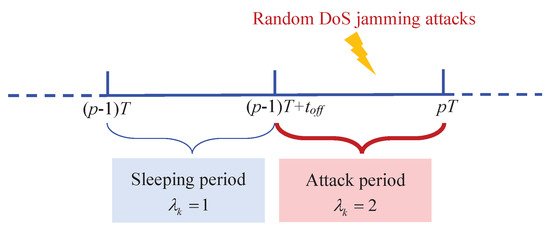
Figure 1.
Periodic random DoS jamming attacks.
Within the ()th ( is an integer) period, instead of launching attacks constantly, the adversary first restores energy without action, and then initiates an efficient random DoS attack. That is, the ()th period is divided into the sleeping period () and the attack period ().
The control signal subject to periodic random DoS jamming attacks is modeled as
where is the actual control input received by the actuator, is the Kronecker delta function characterizing the current period (, ) with
and is a Bernoulli-distributed stochastic variable that satisfies
with being a given scalar. From (7), it is obvious that when and , DoS attack occurs, and when and , DoS attack does not occur. It is evident that . The system structure studied in this paper is illustrated in Figure 2.
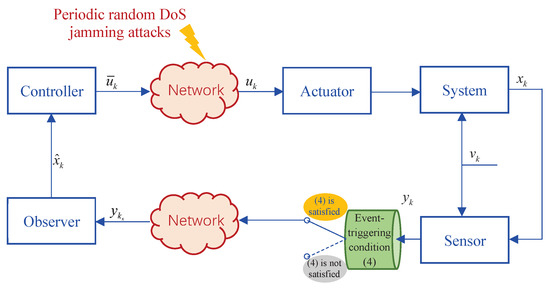
Figure 2.
Structure of networked control system.
Now, we introduce the following definition which is important for subsequent analysis.
Definition 1
([53]). The closed-loop system (9) is exponentially mean-square stable if there are scalars and such that the following inequality:
holds.
The aim of this paper is to design a PID controller with the form (6) which realizes the following two conditions concurrently:
(Q1) The closed-loop system is exponentially mean-square stable;
(Q2) For a given scalar , the controlled output under the initial condition satisfies
for all nonzero , where is a given scalar characterizing the disturbance rejection level.
3. Main Results
A crucial Lemma is given as follows to assist with analysis.
Lemma 1
([42]). Let be a positive semi-definite matrix, , and constants (). If the series is convergent, then one has
3.1. Performance Analysis of Stability and Noise Rejection
The main purpose of this section is, for discrete networked control systems (1) subjected to periodic random DoS jamming attacks (7), to design a PID controller to achieve system stability and meet specific requirements. In order to ensure that the system realizes the nature index on the basis of exponentially mean-square stability, Theorems 1 and 2 outline strict standard requirements. Then, the PID controller related data are fine-tuned on account of the resulting matrix inequality.
Theorem 1.
Let the scalars μ and γ, and matrices L, , and be known. The system (9) under periodic random DoS jamming attacks is exponentially mean-square stable and satisfies the performance constraint (11) if there exist positive definite matrices P, (), Q and a positive scalar σ such that the following inequality is satisfied:
where
Proof of Theorem 1.
Step 1. Define the Lyapunov–Krasovskii functional and compute the mathematical expectation of its difference with .
Define the Lyapunov–Krasovskii functional as follows:
where
Calculating the expectation of the difference of with , we can obtain
where ,
and
Step 2. Utilize the constraints on infinitely distributed delays and event-triggered mechanism.
According to Lemma 1, it is convenient to yield
where is defined in (2).
In addition, considering the event-triggered mechanism (3) and (4), the following inequality is obtained:
Step 3. Analyze the exponential mean-square stability (10) of closed-loop system (9) via a manipulation technique of matrix inequality and realize the stability objective.
Applying the Schur Complement Lemma [54], it is obvious that can be ensured by (12). For a sufficiently small scalar , one has
According to the definition of , it is found that
and
For an arbitrary scalar , we can deduce that
with .
Letting
we obtain
It is easy to prove that there exists so that . On the basis of (23), (26) and (28), we can obtain
which indicates the exponential stability of system (9) in mean square.
Step 4. Discuss the performance (11) of system with nonzero under zero-initial condition and achieve the performance objective.
Next, we continue to verify the property (11) of the system (9) under the zero-initial condition. On the basis of (20), we find that
where
Summing up both sides in (31) concerning k from 0 to ∞ under a zero initial condition, we can acquire
At this point, the proof has been completed. □
Theorem 1 comprises the overall performance analysis result (12) for the closed-loop system (9) containing stability (10) and noise rejection (11). The proof of Theorem 1 is used to carry out performance analysis. Noting that the inequality (12) in Theorem 1 is nonlinear and cannot be solved directly for the gain parameters, further disposal is carried out in the following.
3.2. Parameter Design of Observer and PID Controller
Based on the performance analysis result in Theorem 1 of stability and noise rejection for system (9) subject to periodic random DoS jamming attacks, we design the gain parameters of the observer-based PID controller (6). In Theorem 2, a sufficient condition is established for the existence of the observer-based PID controller (5) and (6) which makes the closed-loop system (9) exponentially mean-square stable, and the gain parameters of the observer-based controller (5) and (6) are designed directly.
Theorem 2.
We consider threshold determining the triggering frequency and the noise rejection level . System (9) meets exponential mean-square stability and performance constraint (12) if there exist positive definite matrices , () and Q, matrices , , , , , and , and a positive scalar σ such that the following inequality is fulfilled:
where
Proof of Theorem 2.
Step 1. Separate nonlinear terms using inequality properties such as Schur Complement Lemma.
Applying the Schur Complement Lemma to (34), one derives
Step 2. Eliminate inverse matrix by denoting new variables, and inequality operation and amplification.
Denote
Expanding the expression of terms (e.g., , , , P) in (37), (37) is converted into the following equivalent inequality:
where
Step 3. Perform variable substitution to express the unknown gain parameters and achieve the design objective of the desired controller.
Remark 2.
So far, we have designed the observer-based PID controller under an event-triggered mechanism. Theorem 1 provides the performance analysis result for the closed-loop system (9) with periodic random DoS jamming attacks and infinitely distributed delays, which shows stability and noise rejection. Depending on Theorem 1, Theorem 2 provides a way to solve the PID controller parameters. That is, by computing a feasible solution to the matrix inequality (33) via the YALMIP toolbox of MATLAB software, the gain parameters of the observer (5) and the controller (6) are obtained directly. All the system parameters are reflected in Theorem 2 such as the occurring probability of periodic random DoS jamming attacks, the threshold determining the triggering frequency, the parameter in the constraint condition of infinitely distributed delays, and the disturbance rejection level.
Remark 3.
Aiming at solving the stability and performance problems of systems under periodic random DoS jamming attacks, this paper designs a PID controller with observer for state estimation. This paper provides the following innovations: (1) the discussed security-guaranteed PID control issue in this paper is new which comprises infinitely distributed delays, event-triggered strategy, and periodic random DoS jamming attacks; (2) the control method is put forward which makes the system be exponentially mean-square stable and satisfy the required performance of noise rejection; and (3) the unknown gain parameters of the observer and the controller are determined conveniently via solving the matrix inequality.
4. Simulation Example
In this section, a numerical simulation example is shown to verify the correctness and effectiveness of the designed PID controller (5) and (6) for system (1).
Targeted at the networked control system (1) under the event-triggered mechanism (4) with the control signal (7) attacked by periodic random DoS jamming attacks in this paper, the following parameters are chosen [55]:
Let the constant sequence be selected as . It is easy to check that , which satisfies the convergence condition (2).
By solving the inequality (33) using the YALMIP toolbox in MATLAB software, the solution set is obtained as follows:
The gain parameters of the observer-based controller (5) and (6) are computed, and stability and noise rejection, using (10) and (11), are achieved as follows:
The disturbance is represented as . The initial states of system (1) are specified as an array of random numbers chosen from a standard normal distribution. The initial states of the observer (5) are set as . The duration of one period is supposed as , the time of replenishing energy is given as , and the total operating time is , namely . The curves obtained through the simulation are shown in Figure 3, Figure 4, Figure 5, Figure 6, Figure 7, Figure 8, Figure 9, Figure 10 and Figure 11. Figure 3 plots the closed-loop control output with the control input and the open-loop output without the control input, respectively. In Figure 3, is the th element of . The open-loop and closed-loop state trajectories are drawn in Figure 4, where shows the 𝚥th element of . In Figure 5, states of system (1) and the observer (5) are plotted, respectively, in which indicates the ℑth element of . The performance is presented in Figure 6, which illustrates that the influence is rejected below index from the external disturbance on the control output. An event-triggering situation is shown in Figure 7. The occurrence situation of periodic random DoS jamming attacks is seen in Figure 8, where means that a DoS attack appears. State and performances are shown in Figure 9 and Figure 10, respectively, under different occurrence probabilities of attack. It is seen that the exponential mean-square stability and the performance are always satisfied using the developed control method in this paper. It also indicates from Figure 9 and Figure 10 that the bigger the occurrence probability of attack, the slower the convergence rate, and the worse the performance. State under different values of thresholds for event-triggering frequency is shown in Figure 11, which exhibits that the bigger the value of , the more difficult it is to realize event triggering (the longer the convergence time). Thus, the simulation results indicate that the designed PID control method is effective and reliable.
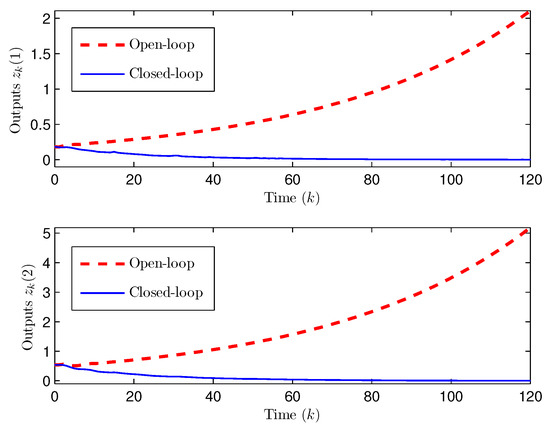
Figure 3.
Outputs .
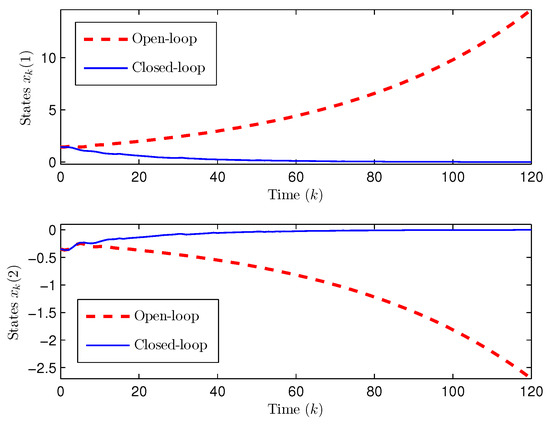
Figure 4.
States .
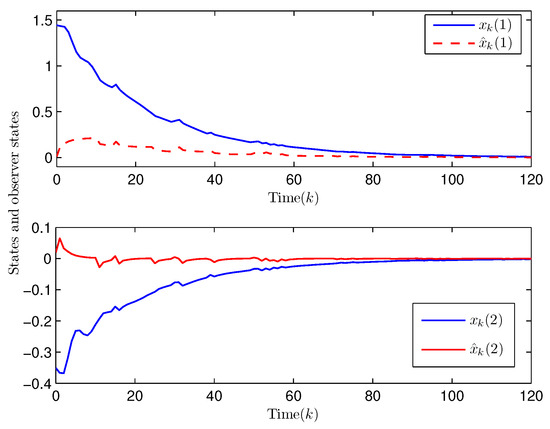
Figure 5.
States and observer states .
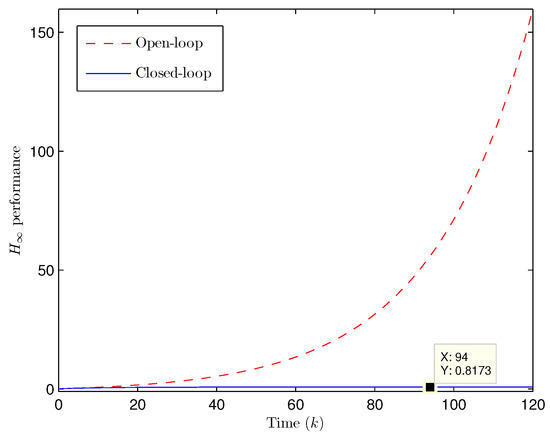
Figure 6.
performance.
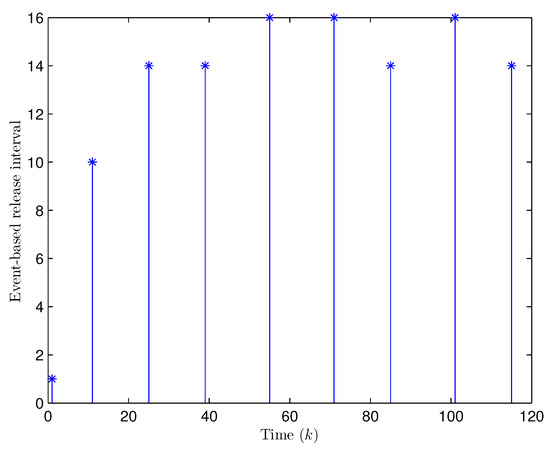
Figure 7.
Event-triggering situation.
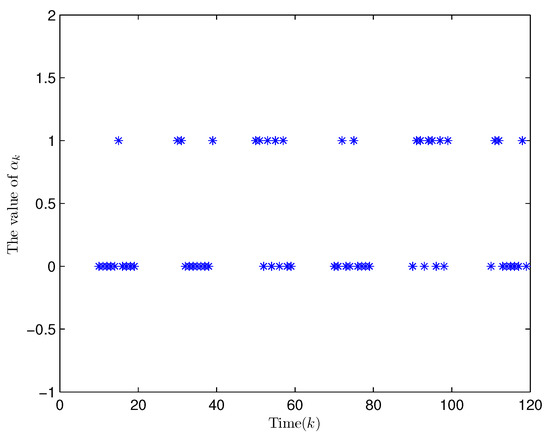
Figure 8.
Occurrence of the periodic random DoS jamming attacks.
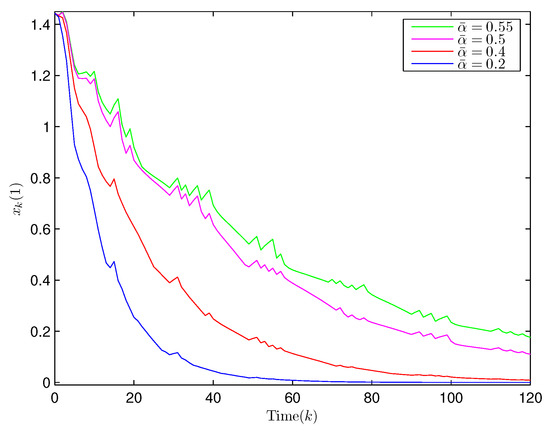
Figure 9.
State under different values of .
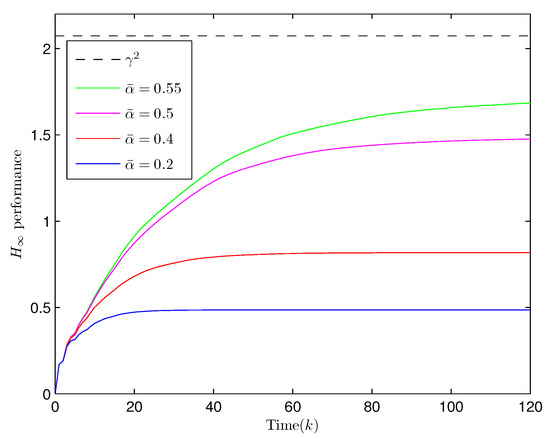
Figure 10.
performance under different values of .
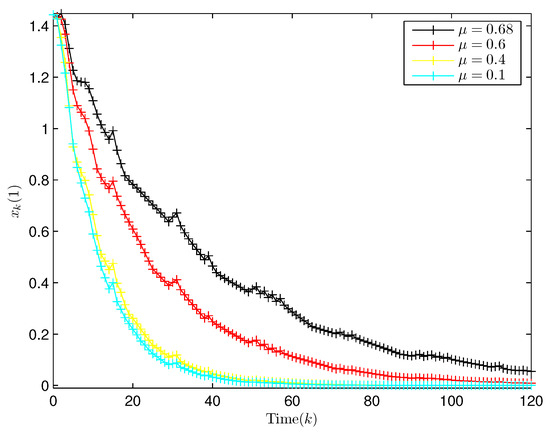
Figure 11.
State under different values of .
5. Discussion and Conclusions
In this paper, an event-triggered PID controller has been designed for systems suffering from periodic random DoS jamming attacks and infinitely distributed delays. Actual periodic random DoS jamming attacks have been modeled using the Kronecker delta function and a Bernoulli-distributed random variable. Infinitely distributed delays have been taken into consideration to coincide with the working situation. A relative event-triggered protocol has been adopted which promotes energy-saving and reduced consumption. An observer-based PID controller has been formulated and devised to achieve the performance requirements for the closed-loop system containing exponential mean-square stability and index by performance analysis. A sufficient condition has been acquired which ensures the existence of the proper observer-based PID controller via stability discussion, stochastic property usage and matrix inequality disposal. Gain parameters of the observer and the PID controller have been solved by computing the feasible solution to a matrix inequality. Simulation results have demonstrated the correctness of the developed PID control method.
In comparison with [17,47], (1) the system model under consideration in this paper is novel and comprehensive, which involves infinitely distributed delays, periodic random DoS jamming attacks and an event-triggered mechanism reducing transmission frequency; (2) the developed control method is new which solves the PID control problem for such a comprehensive system due to the existing methods being no longer valid without considering the influence of delays, periodic random DoS jamming attacks and the event-triggered mechanism; and (3) gain parameters of both the observer and the PID controller for such a comprehensive system are computed conveniently by solving the feasible solution to a specific matrix inequality.
Note that the developed PID control method can be applied to the control problem of a geared DC motor of the MS150 Modular Servo System [56], and the diesel engine (with an exhaust gas recirculation, valve and a turbo compressor with a variable geometry turbine) [57].
There exist some limitations to this paper, including that (1) the employed way to guarantee security is “passive”; and (2) the adoption of a big/improper event-triggered threshold may reduce the control effect. As for future research topics, we would like to (1) consider an “active” way to guarantee security, such as attack compensation [58]; (2) perform controller design by utilizing the dynamic event-triggering mechanism with an adaptive threshold [12]; and (3) extend the obtained result to more complex systems such as systems with uncertainty [3], multi-rate measurement [22], encoding-decoding schemes [17] and other communication protocols [10,25].
Author Contributions
Methodology, D.Z. and W.L.; software, F.Y.; validation, N.H., W.L. and Y.S.; formal analysis, F.Y.; investigation, D.Z.; writing—original draft preparation, D.Z.; writing—review and editing, N.H. and Y.S. All authors have read and agreed to the published version of the manuscript.
Funding
This research was funded in part by the National Natural Science Foundation of China under Grants U21A2019, 62073070 and 62103096, the Hainan Province Science and Technology Special Fund of China under Grant ZDYF2022SHFZ105, the Hainan Provincial Joint Project of Sanya Yazhou Bay Science and Technology City of China under Grant 2021JJLH0025, the Natural Science Foundation of Heilongjiang Province of China under Grant LH2021F006, the Fundamental Research Funds for Undergraduate Universities Affiliated to Heilongjiang Province of China under Grant XNYXLY202104, and the Alexander von Humboldt Foundation of Germany.
Data Availability Statement
Not applicable.
Conflicts of Interest
The authors declare no conflict of interest.
References
- Wang, L.; Zhao, D.; Zhang, Y.; Ding, D.; Yi, X. Gain-scheduled state estimation for discrete-time complex networks under bit-rate constraints. Neurocomputing 2022, 488, 120–129. [Google Scholar] [CrossRef]
- Shi, P.; Sun, W.; Yang, X.; Rudas, I.J.; Gao, H. Master-slave synchronous control of dual drive gantry stage with cogging force compensation. IEEE Trans. Syst. Man Cybern. Syst. 2023, 53, 216–225. [Google Scholar] [CrossRef]
- Tan, H.; Shen, B.; Peng, K.; Liu, H. Robust recursive filtering for uncertain stochastic systems with amplify-and-forward relays. Int. J. Syst. Sci. 2020, 51, 1188–1199. [Google Scholar] [CrossRef]
- Liu, Z.; Gao, H.; Lin, W.; Qiu, J.; Rodríguez-Andina, J.J.; Qu, D. B-spline wavelet neural network-based adaptive control for linear motor-driven systems via a novel gradient descent algorithm. IEEE Trans. Ind. Electron. 2023, in press. [Google Scholar] [CrossRef]
- Cai, M.; He, X.; Zhou, D. Performance-improved finite-time fault-tolerant control for linear uncertain systems with intermittent faults: An overshoot suppression strategy. Int. J. Syst. Sci. 2022, 53, 3408–3425. [Google Scholar] [CrossRef]
- Bu, X.; Hou, Z.; Zhang, H. Data-Driven multiagent systems consensus tracking using model free adaptive control. IEEE Trans. Neural Netw. Learn. Syst. 2018, 29, 1514–1524. [Google Scholar] [CrossRef]
- Gao, C.; He, X.; Dong, H.; Liu, H.; Lyu, G. A survey on fault-tolerant consensus control of multi-agent systems: Trends, methodologies and prospects. Int. J. Syst. Sci. 2022, 53, 2800–2813. [Google Scholar] [CrossRef]
- Wang, L.; Zhao, D.; Wang, Y.-A.; Ding, D.; Liu, H. Partial-neurons-based state estimation for artificial neural networks under constrained bit rate: The finite-time case. Neurocomputing 2022, 488, 144–153. [Google Scholar] [CrossRef]
- Su, Y.; Cai, H.; Huang, J. The cooperative output regulation by the distributed observer approach. Int. J. Netw. Dynam. Int. 2022, 1, 20–35. [Google Scholar] [CrossRef]
- Liu, Y.; Wang, Z.; Liu, C.; Coombes, M.; Chen, W.-H. Auxiliary particle filtering over sensor networks under protocols of amplify-and-forward and decode-and-forward relays. IEEE Trans. Signal Inf. Process. Netw. 2022, 8, 883–893. [Google Scholar] [CrossRef]
- Tan, H.; Shen, B.; Li, Q.; Qian, W. Recursive filtering for nonlinear systems with self-interferences over full-duplex relay networks. IEEE-CAA J. Autom. 2022, 9, 2037–2040. [Google Scholar] [CrossRef]
- Zhao, D.; Wang, Z.; Wei, G.; Han, Q.-L. A dynamic event-triggered approach to observer-based PID security control subject to deception attacks. Automatica 2020, 120, 109128:1–109128:13. [Google Scholar] [CrossRef]
- Zhao, D.; Wang, Z.; Ho, D.W.C.; Wei, G. Observer-based PID security control for discrete time-delay systems under cyber-attacks. IEEE Trans. Syst. Man Cybern. Syst. 2021, 51, 3926–3938. [Google Scholar] [CrossRef]
- Su, C.-L.; Chang, W.-J.; Pen, C.-L. Decentralized multi-performance fuzzy control for nonlinear large-scale descriptor systems. Processes 2022, 10, 2578. [Google Scholar] [CrossRef]
- Zhang, Q.; Zhou, Y. Recent advances in non-Gaussian stochastic systems control theory and its applications. Int. J. Netw. Dynam. Int. 2022, 1, 111–119. [Google Scholar] [CrossRef]
- Chang, W.-J.; Lin, Y.-W.; Lin, Y.-H.; Pen, C.-L.; Tsai, M.-H. Actuator saturated fuzzy controller design for interval Type-2 Takagi-Sugeno fuzzy models with multiplicative noises. Processes 2021, 9, 823. [Google Scholar] [CrossRef]
- Wen, P.; Dong, H.; Huo, F.; Li, J.; Lu, X. Observer-based PID control for actuator-saturated systems under binary encoding scheme. Neurocomputing 2022, 499, 54–62. [Google Scholar] [CrossRef]
- Zhao, D.; Wang, Z.; Ding, D.; Wei, G. H∞ PID control with fading measurements: The output-feedback case. IEEE Trans. Syst. Man Cybern. Syst. 2020, 50, 2170–2180. [Google Scholar] [CrossRef]
- Lian, S.; Meng, W.; Lin, Z.; Shao, K.; Zheng, J.; Li, H.; Lu, R. Adaptive attitude control of a quadrotor using fast nonsingular terminal sliding mode. IEEE Trans. Ind. Electron. 2022, 69, 1597–1607. [Google Scholar] [CrossRef]
- Liu, Z.; Lin, W.; Yu, X.; Rodríguez-Andina, J.J.; Gao, H. Approximation-free robust synchronization control for dual-linear-motors-driven systems with uncertainties and disturbances. IEEE Trans. Ind. Electron. 2022, 69, 10500–10509. [Google Scholar] [CrossRef]
- Bao, G.; Ma, L.; Yi, X. Recent advances on cooperative control of heterogeneous multi-agent systems subject to constraints: A survey. Syst. Sci. Control Eng. 2022, 10, 539–551. [Google Scholar] [CrossRef]
- Zhao, D.; Wang, Z.; Wang, L.; Wei, G. Proportional-integral observer design for multirate-networked systems under constrained bit rate: An encoding-decoding mechanism. IEEE Trans. Cybern. 2022, in press. [Google Scholar] [CrossRef] [PubMed]
- Zhao, D.; Wang, Z.; Chen, Y.; Wei, G.; Sheng, W. Partial-neurons-based proportional-integral observer design for artificial neural networks: A multiple description encoding scheme. IEEE Trans. Neural Netw. Learn. Syst. 2022, in press. [Google Scholar] [CrossRef]
- Yang, F.; Li, J.; Dong, H.; Shen, Y. Proportional-integral-type estimator design for delayed recurrent neural networks under encoding-decoding mechanism. Int. J. Syst. Sci. 2022, 53, 2729–2741. [Google Scholar] [CrossRef]
- Meng, X.; Chen, Y.; Ma, L.; Liu, H. Protocol-based variance-constrained distributed secure filtering with measurement censoring. Int. J. Syst. Sci. 2022, 53, 3322–3338. [Google Scholar] [CrossRef]
- Sun, Y.; Tian, X.; Wei, G. Finite-time distributed resilient state estimation subject to hybrid cyber-attacks: A new dynamic event-triggered case. Int. J. Syst. Sci. 2022, 53, 2832–2844. [Google Scholar] [CrossRef]
- Yao, F.; Ding, Y.; Hong, S.; Yang, S.-H. A survey on evolved LoRa-based communication technologies for emerging internet of things applications. Int. J. Netw. Dynam. Int. 2022, 1, 4–19. [Google Scholar] [CrossRef]
- Pang, Z.H.; Fan, L.Z.; Guo, H.; Shi, Y.; Chai, R.; Sun, J.; Liu, G. Security of networked control systems subject to deception attacks: A survey. Int. J. Syst. Sci. 2022, 53, 3577–3598. [Google Scholar] [CrossRef]
- Zou, L.; Wang, Z.; Hu, J.; Liu, Y.; Liu, X. Communication-protocol-based analysis and synthesis of networked systems: Progress, prospects and challenges. Int. J. Syst. Sci. 2021, 52, 3013–3034. [Google Scholar] [CrossRef]
- Tao, H.; Tan, H.; Chen, Q.; Liu, H.; Hu, J. H∞ state estimation for memristive neural networks with randomly occurring DoS attacks. Syst. Sci. Control Eng. 2022, 10, 154–165. [Google Scholar] [CrossRef]
- Su, L.; Ye, D. Reprint of: Observer-based output feedback H∞ control for cyber-physical systems under randomly occurring packet dropout and periodic DoS attacks. ISA Trans. 2020, 104, 26–35. [Google Scholar] [CrossRef] [PubMed]
- Li, X.-M.; Yao, D.; Li, P.; Meng, W.; Li, H.; Lu, R. Secure finite-horizon consensus control of multiagent systems against cyber attacks. IEEE Trans. Cybern. 2022, 52, 9230–9239. [Google Scholar] [CrossRef] [PubMed]
- Yu, G.-R.; Chang, Y.-D.; Chang, C.-H. Synthesis of polynomial fuzzy model-based designs with synchronization and secure communications for chaos systems with H∞ performance. Processes 2021, 9, 2088. [Google Scholar] [CrossRef]
- Wu, J.; Peng, C.; Yang, H.; Wang, Y.L. Recent advances in event-triggered security control of networked systems: A survey. Int. J. Syst. Sci. 2022, 53, 2624–2643. [Google Scholar] [CrossRef]
- Xiao, B.; Hu, Q.; Zhang, Y. Adaptive sliding mode fault tolerant attitude tracking control for flexible spacecraft under actuator saturation. IEEE Trans. Control Syst. Technol. 2012, 20, 1605–1612. [Google Scholar] [CrossRef]
- Wang, Y.; Ren, W.; Liu, Z.; Li, J.; Zhang, D. T-S fuzzy model-based fault detection for continuous stirring tank reactor. Processes 2021, 9, 2127. [Google Scholar] [CrossRef]
- Wang, X.; Sun, Y.; Ding, D. Adaptive dynamic programming for networked control systems under communication constraints: A survey of trends and techniques. Int. J. Netw. Dynam. Int. 2022, 1, 85–98. [Google Scholar] [CrossRef]
- Hou, Z.; Xiong, S. On model-free adaptive control and its stability analysis. IEEE Trans. Autom. Control 2019, 64, 4555–4569. [Google Scholar] [CrossRef]
- Wang, L.; Liu, S.; Zhang, Y.; Ding, D.; Yi, X. Non-fragile l2-l∞ state estimation for time-delayed artificial neural networks: An adaptive event-triggered approach. Int. J. Syst. Sci. 2022, 53, 2247–2259. [Google Scholar] [CrossRef]
- Zhang, Y.; Jiang, J. Fault tolerant control system design with explicit consideration of performance degradation. IEEE Trans. Aerosp. Electron. Syst. 2003, 39, 838–848. [Google Scholar] [CrossRef]
- Zhuang, G.; Wang, X.; Xia, J.; Wang, Y. Observer-based asynchronous feedback H∞ control for delayed fuzzy implicit jump systems under HMM and event-trigger mechanisms. Inf. Sci. 2023, 631, 45–64. [Google Scholar] [CrossRef]
- Liu, Y.; Wang, Z.; Liang, J.; Liu, X. Synchronization and state estimation for discrete-time complex networks with distributed delays. IEEE Trans. Syst. Man Cybern. Part B (Cybern.) 2008, 38, 1314–1325. [Google Scholar]
- Xu, J.; Sheng, L.; Gao, M. Fault estimation for nonlinear systems with sensor gain degradation and stochastic protocol based on strong tracking filtering. Syst. Sci. Control Eng. 2021, 9, 60–70. [Google Scholar] [CrossRef]
- Shakiba, F.M.; Shojaee, M.; Azizi, S.M.; Zhou, M. Real-time sensing and fault diagnosis for transmission lines. Int. J. Netw. Dynam. Int. 2022, 1, 36–47. [Google Scholar] [CrossRef]
- Voortman, Q.; Efimov, D.; Pogromsky, A.Y.; Richard, J.-P.; Nijmeijer, H. An event-triggered observation scheme for systems with perturbations and data rate constraints. Automatica 2022, 145, 110512:1–110512:10. [Google Scholar] [CrossRef]
- Li, M.; Liang, J.; Wang, F. Robust set-membership filtering for two-dimensional systems with sensor saturation under the Round-Robin protocol. Int. J. Syst. Sci. 2022, 53, 2773–2785. [Google Scholar] [CrossRef]
- Wen, P.; Li, X.; Hou, N.; Mu, S. Distributed recursive fault estimation with binary encoding schemes over sensor networks. Syst. Sci. Control Eng. 2022, 10, 417–427. [Google Scholar] [CrossRef]
- Li, X.; Han, F.; Hou, N.; Dong, H.; Liu, H. Set-membership filtering for piecewise linear systems with censored measurements under Round-Robin protocol. Int. J. Syst. Sci. 2020, 51, 1578–1588. [Google Scholar] [CrossRef]
- Shen, W.; Liu, S.; Liu, M. Adaptive sliding mode control of hydraulic systems with the event trigger and finite-time disturbance observer. Inf. Sci. 2021, 569, 55–69. [Google Scholar] [CrossRef]
- Tan, Y.; Liu, J.; Xie, X.; Tian, E.; Liu, J. Event-triggered sliding-mode control for fuzzy semi-Markovian jump systems with dead zone input and application to circuit systems. IEEE Trans. Circuits Syst. II Express Briefs 2023, in press. [Google Scholar] [CrossRef]
- Li, C.; Wang, Z.; Song, W.; Zhao, S.; Wang, J.; Shan, J. Resilient unscented Kalman filtering fusion with dynamic event-triggered scheme: Applications to multiple unmanned aerial vehicles. IEEE Trans. Control Syst. Technol. 2023, 31, 370–381. [Google Scholar] [CrossRef]
- Jia, C.; Hu, J.; Chen, D.; Cao, Z.; Huang, J.; Tan, H. Adaptive event-triggered state estimation for a class of stochastic complex networks subject to coding-decoding schemes and missing measurements. Neurocomputing 2022, 494, 297–307. [Google Scholar] [CrossRef]
- Shen, Y.; Wu, Z.-G.; Shi, P.; Chen, B. H∞ control of constrained Markov jump systems with intermittent mode information loss. IEEE Trans. Autom. Control 2023, in press. [CrossRef]
- Boyd, S.; Ghaoui, L.E.; Feron, E.; Balakrishnan, V. Linear Matrix Inequalities in System and Control Theory; SIAM: Philadelphia, PA, USA, 1994; pp. 7–8. [Google Scholar]
- Li, Z.; Wang, Z.; Ding, D.; Shu, H. Non-fragile H∞ control with randomly occurring gain variations, distributed delays and channel fadings. IET Control Theory Appl. 2015, 9, 222–231. [Google Scholar] [CrossRef]
- Zhang, H.; Shi, Y.; Mehr, A.S. Robust static output feedback control and remote PID design for networked motor systems. IEEE Trans. Ind. Electron. 2011, 58, 5396–5405. [Google Scholar] [CrossRef]
- Zhang, X.-M.; Han, Q.-L. A decentralized event-triggered dissipative control scheme for systems with multiple sensors to sample the system outputs. IEEE Trans. Cybern. 2016, 46, 2745–2757. [Google Scholar] [CrossRef] [PubMed]
- Su, L.; Ye, D. A cooperative detection and compensation mechanism against denial-of-service attack for cyber-physical systems. Inform. Sci. 2018, 444, 122–134. [Google Scholar] [CrossRef]
Disclaimer/Publisher’s Note: The statements, opinions and data contained in all publications are solely those of the individual author(s) and contributor(s) and not of MDPI and/or the editor(s). MDPI and/or the editor(s) disclaim responsibility for any injury to people or property resulting from any ideas, methods, instructions or products referred to in the content. |
© 2023 by the authors. Licensee MDPI, Basel, Switzerland. This article is an open access article distributed under the terms and conditions of the Creative Commons Attribution (CC BY) license (https://creativecommons.org/licenses/by/4.0/).